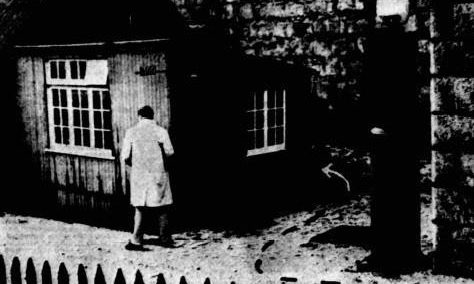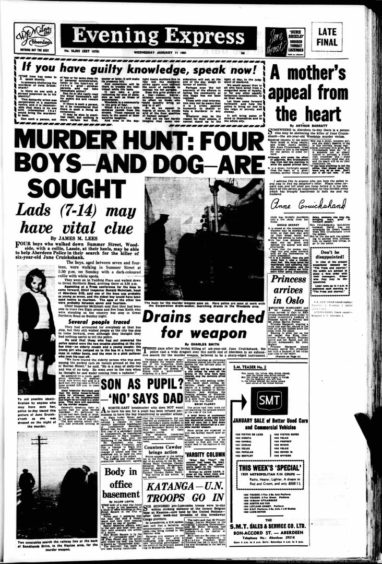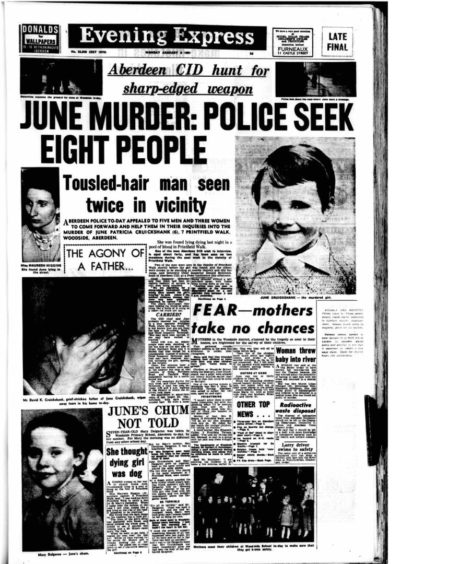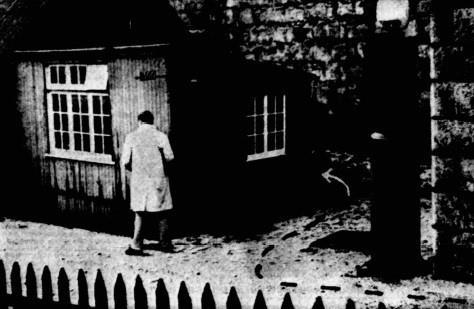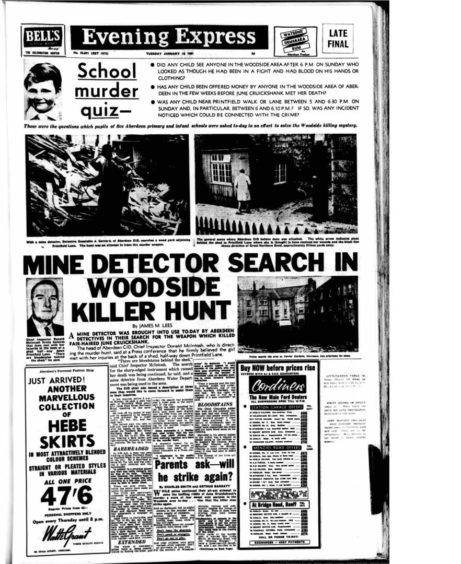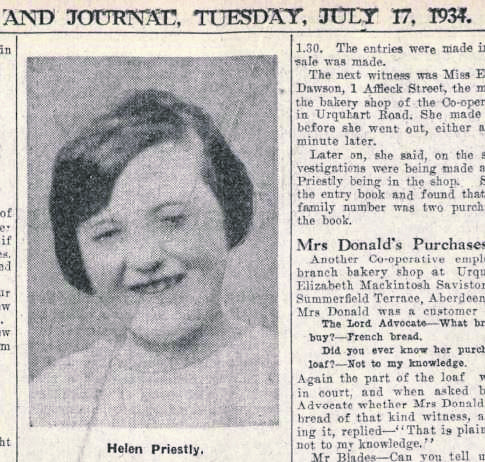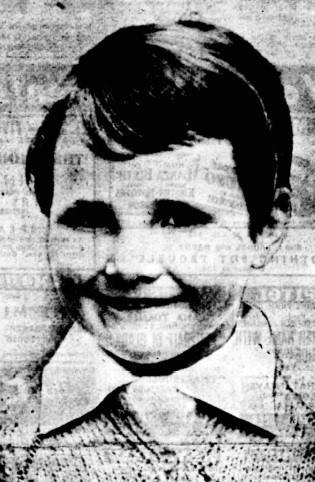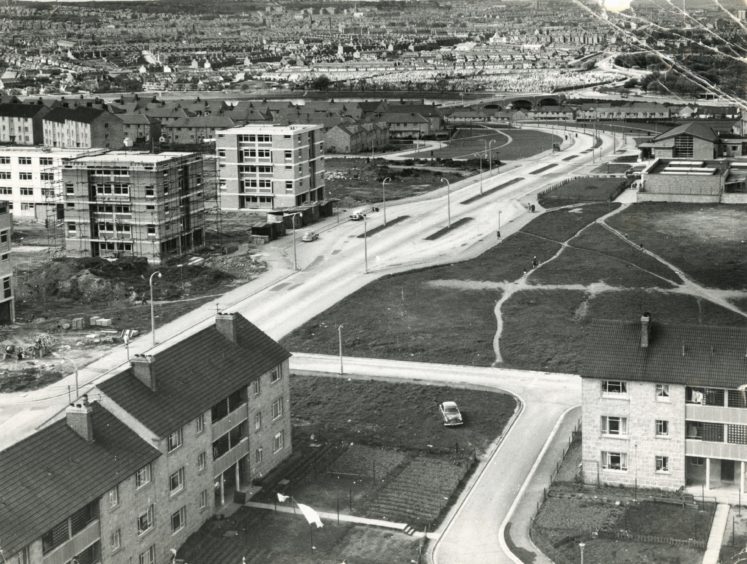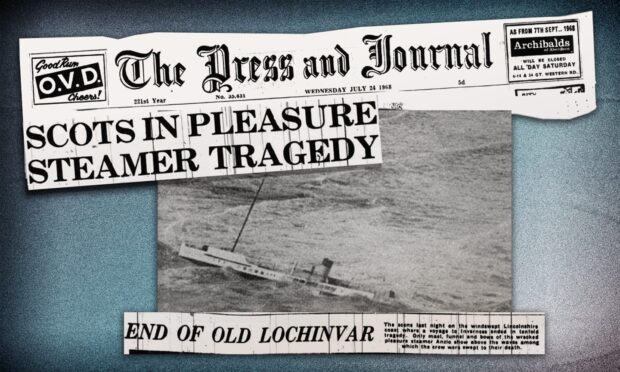It all started with a young girl being sent by her parents to buy a packet of custard powder from a nearby shop in Aberdeen.
That should have meant a routine few hops and a skip outside for the child who lived with her parents and brothers and sisters at 7 Printfield Walk and who had already become a very popular figure in the area where she played with her friends.
Yet, even now, 60 years later, the tragedy which ensued when six-year-old June Cruickshank was murdered by a man who escaped punishment for his crime and struck again to kill another child two years later, is sufficient to chill the blood.
Maureen Higgins was on her way to church on the evening of Sunday January 8 1961 when she suddenly spotted an unkempt unidentified bundle just a few yards away.
I placed my coat over the wee girl
As the 26-year-old recalled: “I was walking to catch a bus for St Mary’s Cathedral, but when I reached the bottom of the street, I saw what looked like a dog lying at the side of the road and it appeared to be crawling.
“I went over and found this little girl and the front of her dress was spattered with blood and it covered the whole area. I looked around to see if anybody else was coming and a [shipyard worker] Robert Munro came down the road.
“When he went to get help, I placed my coat over the wee girl.”
However, there was nothing else to be done for her and, in the next few hours, news began to spread of how June had been killed, as the city’s police force responded to the crime, while parents in the Woodside area, stunned by hearing about the tragedy, were frightened for the safety of their children.
Police issued details of a man with tousled hair
Detective Chief Inspector Donald McIntosh, the head of Aberdeen CID, confirmed the grim details the next morning where he revealed how June has been found dying in a gutter with a dreadful wound to her neck.
Shortly before 6pm, her killer had lured her into a dark lane – a cul-de-sac on the north-east side of Great Northern Road – where he brutally cut her throat.
It emerged that the stricken youngster had somehow found the strength to cross the main road before collapsing in a pool of blood, within sight of the lights of her home.
DCI McIntosh told a press conference on January 9: “We are searching for a sharp-edged instrument which would have caused the injuries.”
He added that officers were looking for five men and three women whom they believed could help them with their inquiries, including a “man with tousled hair” who became one of the pivotal figures in the subsequent investigation.
Yet, as the police worked hard to reassure the public, and conduct their hunt for the perpetrator, there were distraught family members and friends who had to break the terrible news to June’s loved ones, who were too young to fully comprehend the horror.
‘She and my youngest lassie were such great pals’
Seven-year-old Mary Dalgarno was among the many pupils who was taken to Woodside Primary School by her mother the following morning.
The wee girl sensed that something was wrong, but had no idea why her mum, Christina, was in such distress.
Mrs Dalgarno later told the Evening Express: “It is all so terrible. June was such a lovely girl and she and my youngest lassie were such great pals that I almost looked on her as being one of my own.”
June, who was one of 30 children in Class 2a at Woodside Primary, was a popular, bright pupil whom teachers described as a joy in their classroom.
But, as mothers spoke about their concerns, June’s sisters Norma, 11, and Anne Marie, four, stayed at home with their brothers, Brian, 12, and David, two, while their parents, David and Anne, attempted to deal with the worst situation they had ever faced.
‘I will do all my own messages from now on’
Newspapers across Scotland on January 9 carried coverage of the shocking murder. But, although the families of other pupils expressed concerns about what had happened, there was no thought of cancelling the normal school arrangements.
The pupils at Woodside Primary were allowed to finish classes 20 minutes earlier than usual, so they could make the journey home while there was still daylight.
One parent said: “It’s frightening to think that these sort of things can happen on your own doorsteps. Another woman added: “I will do my own messages from now on.
“My oldest boy can watch the younger children, because I am taking no chances.”
This was the most depraved of all crimes
But, despite the initial sense of near panic, there was little sign of progress in the case. The information received from the public came to nothing, the investigation stalled and, even after June’s funeral, there was no hint of a breakthrough.
Several different leads, extending as far as London, were followed up and dismissed. Anonymous tip-offs, blaming particular individuals, proved an unwelcome distraction for officers and the reluctance of potentially vital witnesses to intervene prompted Highland novelist Jane Duncan to write an impassioned letter to the Press and Journal.
She urged people to come forward to help solve “the most depraved of all crimes – child murder” and argued that if they didn’t, they were “an accessory” to the crime.
Appeals were issued in the press and from the pulpit, between 10,000 and 15,000 houses were visited throughout the city and DCI McIntosh made a loudspeaker appeal to the 20,000 supporters at the Aberdeen v Celtic match at Pittodrie on the Saturday after the little girl’s murder.
But, as weeks and months turned to years, it seemed her killer might never be caught.
The coin which told its story too late
Every available policeman and detective had turned out and worked conscientiously in a bid to solve Aberdeen’s biggest murder hunt for decades – and the first violent death of a child since Helen Priestly, eight, had been killed by a neighbour in 1934.
Yet, unbeknown to the public, the murder squad team were in receipt of a clue that eventually provided a link to the killer.
The item had turned up when June’s distraught mother had hurried to her dying daughter’s side and a female bystander spotted a gleam of silver lying beside the body.
It was a one-shilling piece, which was originally – and erroneously – thought to be dropped change from the shop where June had purchased the custard powder.
Instead, it eventually emerged that the coin had been given to June by her murderer. But this wasn’t the dramatic development which helped crack the case.
On the contrary, it only became a relevant factor after a second death.
Another child, another hunt across the Granite City
The Press and Journal reported in the summer of 1963 the bare details of how police were searching for a missing boy, George Forbes.
The seven-year-old said farewell in sign language to his deaf parents Mary and John on July 7, telling them he “wouldn’t be long” as he left their Aberdeen tenement home on the corner of Justice Street and Commerce Street.
He never returned.
In the days ahead, the acting head of Aberdeen City Police, Hugh McQueen, launched the most intensive search which had been carried out since June Cruickshank’s murder.
Asked if there was any possibility of foul play, the acting chief constable replied: “He has disappeared completely. Everything is being investigated, we are clutching at every straw, but so far, we haven’t a clue, we haven’t a thing to go on.
“Children have been coming up with many possibilities and they have been thoroughly investigated. Derelict buildings in the area and sheds on the quays have been searched [because of George’s habit of visiting the harbour area to feed the pigeons].”
John Forbes and his family scoured the city
The hunt intensified and nobody was more committed to achieving a successful outcome than the missing boy’s distraught father.
He started scouring the East End of the city, desperately asking members of the public if they had seen his son. Day after day, he continued his pursuit and was joined by George’s sister, Helen, 12, and brother Kenneth, nine.
A major police presence throughout Aberdeen testified to the seriousness with which officers were treating the situation, but they were scarcely helped by the city being emptier than normal due to the summer holidays.
The P&J reported a week after his disappearance on July 15: “There was still no trace yesterday of Aberdeen schoolboy George Forbes.
“Although no fresh leads have emerged, his mother is still hoping that he will turn up. And a CID spokesman said that the search was continuing.”
These words became wearily familiar for the heartbroken family. And, though there was no sign of a body as summer turned to autumn, everybody drew the same conclusion.
A breakthrough finally emerges in the darkness
Months had passed since George Forbes had vanished. And there had never been any resolution to the shocking murder of June Cruickshank.
But suddenly, on Tuesday November 19 1963, the Press and Journal’s front page testified to dramatic and harrowing developments in the case.
It reported: “The agony of events that happened nearly three years ago returned to the Cruickshank family of Kincorth, Aberdeen yesterday with the news that a man had been charged with the murder of their six-year-old daughter June.
“Thirty-nine-year-old labourer James John Oliphant, c/o McLeod, 48 Market Street, Aberdeen, was charged with the murder of June, then living at 7 Printfield Walk, on Sunday, January 8 1961 and of George Forbes, 46 Justice Street, on Sunday July 7 1963.
“George had gone missing about four months ago and body was found on Saturday, buried in the earthen floor of a greenhouse.
“Oliphant, who made a brief appearance in private before Sheriff James Aikman Smith, was also charged with three indecency offences and one of assault.
“He was remanded for further inquiries.”
The developments happened by accident
Officers had actually been questioning Oliphant about an attack on another boy when he confessed to being the perpetrator of the double murder.
He was quoted as saying: “I’ll take you to where that loon Forbes is. He’s down at my greenhouse. He started screaming and I cut his throat with a knife.”
After that startling revelation, the police quizzed him about what had happened to June, and he quickly admitted: “Aye, it was me. I gave her a shilling.
“I took her round the back of the petrol place. Later she started screaming.
“I ken I’ll get hung for this. I’m finished.”
Then Oliphant began to cry in front of his interrogators.
The trial of James John Oliphant
The news of an arrest and a confession offered little comfort to the families of both victims. Both had already suffered unimaginable grief.
When Oliphant eventually appeared in the dock at a Sheriff Court Pleading Diet on Monday February 3 1964, the powerfully-built Caithness man, who had worked on a farm near Wick and learned to slaughter pigs by cutting their throats, was asked by Sheriff Archibald Hamilton how he would plead to the indictment of six charges, and he showed no emotion as he replied; “Guilty, sir”.
After consulting psychiatric reports, the Sheriff sent the accused to the High Court – which was due to meet in Aberdeen eight days later – for sentencing.
The late journalist and author, Norman Adams, highlighted the events of February 11 in the courtroom in his book Blood and Granite.
As he said: “Oliphant maintained his sphinx-like expression when he returned to the courtroom. Mr James Law, advocate-depute, told the judge Lord Strachan that the charges, relating to June and George, were originally ones of murder, but had been reduced to culpable homicide because of Oliphant’s diminished responsibility.
“Medical witnesses warned that, if he was ever set free, there was a chance that he might kill again. Psychiatrist Dr James Henderson said that a sexual relationship between Oliphant and his stepfather, which had been forced on him as a boy, has had a lasting effect on him.
“This resulted in him trying to force others to suffer as he himself had suffered.
“At no time did Oliphant show any remorse for his actions and nor did he express any concern for the relatives of the children involved [in his crimes].”
The verdict offered no solace to the bereaved
Several medical experts shared the same opinion that Oliphant had no conscience about assaulting and abusing children and resorting to violence if they screamed.
Lord Strachan, after hearing their testimony, which included several other instances of lewd behaviour, reached the verdict that Oliphant should be sent to Carstairs State Mental Hospital “without limit of time”.
This meant the only person who could free him was the Scottish Secretary and that could only happen if he believed there were good grounds for his release.
But, even if this meant a life sentence for the killer, there was no sense of solace or closure with Oliphant’s punishment and incarceration.
Instead, there was simply anger and bewilderment that the lives of two children could be snuffed out by somebody who took no responsibility for his actions.
The two families met and shared their grief
One evening in 1964, shortly after Oliphant had been convicted, June and George’s parents met each other for the first time.
Anne and David Cruickshank travelled to the Forbes’ home in Justice Street and they shared their mutual grief over a pot of tea.
Oliphant died in Carstairs early in 1988, with the news confirmed by the Scottish Office on March 1, after he had spent nearly a quarter of a century behind bars.
As Mr Adams wrote: “His allotment disappeared after Commerce Street and road improvements also resulted in the Forbes’ home being demolished.
“The family was subsequently re-housed. And the cul-de-sac where June Cruickshank met her tragic end and Kincaid’s shop, where she bought custard powder, are no more.”
Six decades later, the senselessness of the tragedies still resounds.
